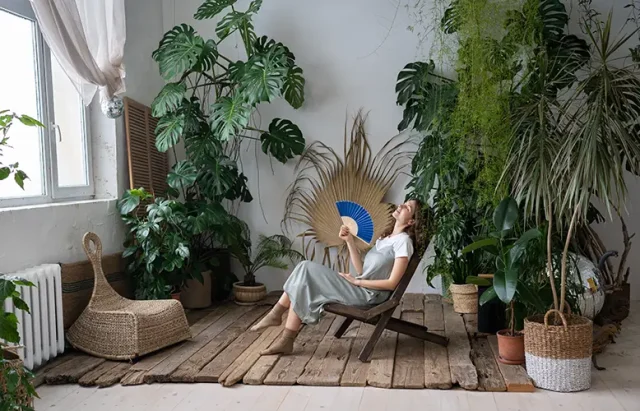
Over the last couple of years, you’ve probably noticed the sudden influx of nature-related aesthetics taking over homes, social media feeds, and design showrooms. They haven’t popped out of the blue either. They’re a response to the constantly growing concern over climate change. Biophilic aesthetic offers an emotional, earthy antidote to eco-anxiety, which is the chronic fear of environmental doom.
What is Biophilic Aesthetic?
Going beyond adding a few houseplants and calling it a day, the biophilic aesthetic is rooted in humanity’s innate connection to nature, as it comes from the term biophilia. When applied to interior design, it aims to strengthen that connection through materials, textures, colours, and layouts that mimic or celebrate the natural world.
Why is the Biophilic Aesthetic Trending?
Blame it on the climate crisis, or rather, the emotional toll it’s taking on people. Eco-anxiety is increasingly widespread, especially among the younger generations. And like all forms of anxiety, it seeps into the spaces we live in.
People want homes that ground them and spaces that make them feel safe, even if the outside world feels uncertain. Biophilic aesthetics offer that desired sense of calm. It’s a visual and sensory reminder that nature still exists and that we can create harmony, at least within our four walls.
Designing with Biophilic Intentions
Natural Materials Matter: Start with the foundations of your home. Swap synthetics for materials with organic origins. For your floors, think about natural grains and warm tones, something like brushed engineered wood that’s durable and feels comfortable underfoot. Stone, marble, or concrete for your worktops are perfect as they age naturally and develop unique patinas over time.
Embrace Plant Life: As the poster child for biophilic interiors, plants improve air quality, reduce stress, and give rooms a living, breathing presence. Large houseplants like fiddle leaf figs and rubber trees bring dramatic greenery to blank corners. But if you’re not great at keeping plants alive, then low-maintenance options like snake plants and pothos are perfect.
Prioritise Natural Light & Outdoor Views: Sunlight is a powerful mood booster and key to maintaining a circadian rhythm. Position mirrors opposite windows to bounce light around darker rooms. Go for lightweight breathable fabrics for curtains to let the light come in. Even in garden-facing rooms, consider French or bi-fold doors to create a seamless connection between indoors and out.
Earthy Colour Palettes: Skip the sterile whites and icy greys in favour of deep greens, clay browns, and sandstone neutrals for a cocooning effect. Incorporate them into your furniture and accent décor to reinforce the earthy atmosphere without overpowering it.
Incorporate Organic Shapes & Patterns: Nature rarely creates straight lines or sharp angles. Mimicking its softness can make interiors feel more fluid and restful. Look around for rounded coffee tables, pebble-shaped mirrors, or curved headboards to break up boxy architecture. Subtly echo nature with herringbone wood floors that mimic fishbones or leaf structures. Even fabrics with abstract botanical prints and patterns can help blur the line between nature and décor.
Is It Worthwhile?
Biophilic aesthetics go beyond surface-level beauty. At a time when many people are feeling overwhelmed, disconnected, or unsure about the future, this design approach offers something deeply valuable: comfort, clarity, and connection.
Eco-anxiety can feel paralysing, especially when it’s all over the news. But bringing nature into the home is one way to counteract that emotional weight. It’s about regaining a sense of control, however small. Creating a space filled with light, greenery, and natural texture can lower stress, improve focus, and even encourage healthier habits, like slow living and more mindful consumption.
Ultimately, this aesthetic aligns personal wellness with planetary wellbeing as well. With homeowners making choices that reflect inner values and external concerns, they’re creating lived-in sustainability that isn’t performative. Plus, biophilic aesthetics are more likely to stick than the usual trends that come and go within weeks.
So, yes. Biophilic design is absolutely worth it. They make homes more liveable, more meaningful, and more future-proof. In the face of eco-anxiety, they offer a rare kind of relief; a daily reminder that nature is still here, even in uncertain times. And with a few conscious design choices, it can be right at home with you. It’s important to remember that biophilic aesthetic isn’t just another design moment; instead, it’s a lifestyle shift.
Author Bio: Sophie Marlowe
Sophie Marlowe is a digital content writer and outreach executive for Luxury Flooring. She specialises in crafting engaging blogs on home improvement and home decor with a focus on flooring. Sophie writes handy how-tos, easy guides, and helpful comparisons, letting the reader be informed and inspired to take their home to the next level.





